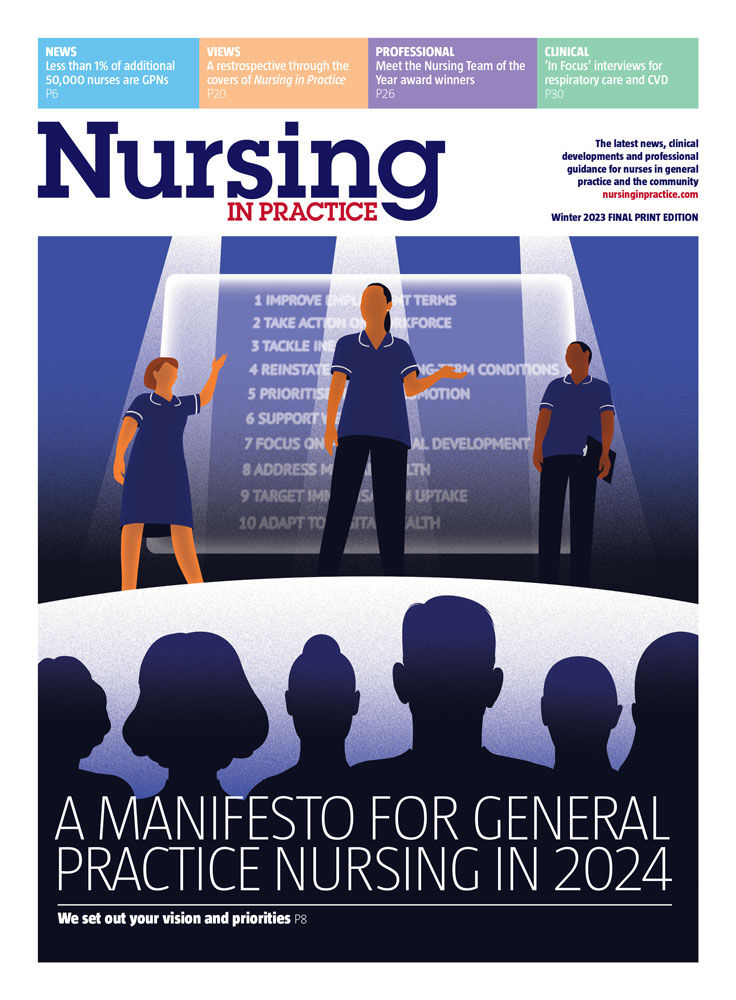Continuing our series of highlights from Nursing in Practice 365 events, nurse specialist in mental health Leila Khan shares insights on assessing and supporting people presenting with suicidal ideation in primary care
Nurses in primary care will inevitably encounter patients in mental distress who are having thoughts of suicide. This ranges from people experiencing a first episode of depression through to those who have been living with diagnosed depression for a long time. As well as those in psychological pain, others who may experience suicidal ideation include patients experiencing acute physical pain, chronic long-term disability or bereavement. In addition, anyone can experience suicidal ideation when faced with social or economic life events such as separation, breakdown of a significant relationship, loss of income or debt.
It is vital for nurses in primary care to be able to manage any such situation where a patient presents with suicidal ideation, to help assess risk and provide the appropriate management. Some nurses may use the PHQ 9 and GAD 7 assessment scales to determine the severity of a person’s depression and/or anxiety, but note that current NICE guidelines on self-harm advise against relying on such tools to assess risk of suicide and instead place greater emphasis on clinical judgement and the documentation of that.
What is suicidal ideation?
First, it is important to know what we mean by suicidal ideation and test our preconceptions.
Consider the following statements – which do you think are true and which are false?
Patients who continually talk about suicide don’t do it True/False If you speak to someone about suicide you are putting the idea in their head True/False Only people with mental ill health experience suicidal thoughts True/False [Answers at the bottom of the article]
There are many myths about suicide, including the common assumption that attempted suicide is a form of attention seeking. Suicide is a complex clinical issue, we can’t second guess if a person is going to end their life or not – and we shouldn’t try to. If someone is talking about ending their life, we have a duty of care to take it seriously. Research demonstrates that talking about suicide does not ‘put the idea in someone’s head’. In addition, 50% of people who experience suicidal thoughts have no diagnosable mental health condition or are not known to Mental Health services.
There is no universal definition of what suicidal ideation is. For example, whether the definition should also include a plan to end life is contested. Academics themselves do not agree on a standard list of criteria of what constitutes suicidal ideation. For the purposes of this article, however, suicidal ideation is the intention of ending one’s life regardless of whether the patient has a plan or not.
Encourage the patient to talk
The vast majority of patients will not talk about their suicidal thoughts unless you ask them directly, or you observe and mention their distress. Do what nurses in primary care do best – use your advanced communication skills to engage the patient, and encourage them to talk to you to identify their needs. It can be hard for patients to talk about their distress, especially in a society that still views suicide as shameful and stigmatises it. Every contact with a distressed person counts. Ask more than once are they okay – are they really okay?
Some more experienced nurses may have their ‘go-to’ phrase when dealing with uncomfortable conversations. For example, ‘I can see from your expression that you are not yourself today’, or ‘I can see that you are really struggling here’, or ‘You say that you are okay but are you really?’, and ‘I’m glad you’ve told me how you are feeling’.
It can be helpful for newly qualified nurses, who may not have the confidence to ask these questions or feel uncomfortable initially, to adopt this approach in practice. However, once you get to know the patient better you will know how to communicate with them.
It is also important to ensure you make time and create the right environment for this kind of important, sensitive conversation. You should find a confidential space where the patient can open up about what they are experiencing, without feeling hurried or that they are not being heard.
Agree a Safety Plan with the patient
A Safety Plan is a tool that can help the individual resist their suicidal thoughts or feelings.
Anything you can do to delay or disrupt suicidal thinking is potentially lifesaving. It is important to help them identify their reasons for living. Even the most suicidal patient can have a life drive. Who or what are their protective factors? What does the patient need right now to get through this? What would make them feel safe? What can they do to lift or calm their thoughts? Who can support them? What can they do to distract themselves from these thoughts?
By exploring these questions you can help the patient complete their Safety Plan to take away and keep close. At this point it is also critical to document your concerns and seek further advice from a senior colleague such as the Designated Safeguarding Lead (DSL) in your practice or setting. Make sure you know what the safeguarding protocol is in your area of work.
Immediate actions on a Safety Plan might include your next appointment with the patient and ensuring they can refer to emergency contact numbers. Note your practice should also have the Samaritans phone number 116 1234 prominently displayed on walls and waiting areas, as well as other helpline numbers, and your local Mental Health Service Single Point of Access. In England, NHS 111 now also has a mental health option.
If you feel a patient is in imminent danger, do not leave them alone but also make sure that you are not putting yourself at risk. Call for an ambulance if the risk is immediate and they will be assessed by Psychiatry Liaison in A&E upon arrival.
Avoid minimising the person’s distress
Try to remain calm, compassionate and supportive even if inside you feel anxious or overwhelmed yourself. However, don’t try to minimise someone’s distress, and be mindful that it is generally unhelpful to compare their experience with those of others.
It is important here to leave aside potential attitudes to suicide and suicidal behaviour that you may hold subconsciously due to factors such as social stigma, or religious observance. For example, suicidal people are sometimes seen as weak, or undeserving of medical help. Remember that as professionals we should be non-judgmental, empathetic and neutral, in keeping with our NMC professional codes of practice and as a registered practitioner. Our role is not to blame or judge others.
Seek support from colleagues
We are only human, and can feel frustration, anger and fear ourselves. To be truly empathetic is not the same as sympathy or pity, and empathy can be emotionally and mentally challenging. Be aware of your own distress or tolerance levels. This is where good individual or group supervision and reflective practice can really come into its own, in building resilience. We are tasked with instilling hope or holding emotional space for the most disadvantaged and vulnerable members within society. This is no easy ask.
As a professional you are also susceptible to compassion fatigue and burnout, so perhaps think about making your own safety and a wellbeing plan. We all need to learn to look after ourselves and each other better.
Leila Khan is an associate practice development nurse in mental health at West London NHS Trust
Answers to the above questions: All false
Further reading and resources
Samaritans. Creating a Safety Plan
Papyrus. Prevention of young suicide. Suicide Safety Plan
Every life matters. Safety planning.
The Staying Safe website has been developed by 4 Mental Health with an expert reference group of over 160 people. It is free and easily accessible for both patients and those who support them.
Mind. Information and support: Suicidal feelings







